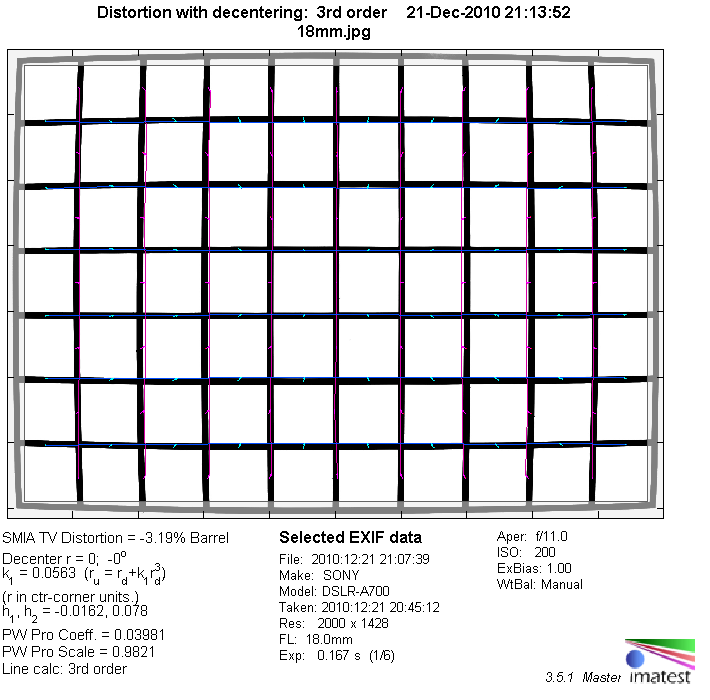|
Sony 18-55mm f/3.5-5.6 SAM DT - Review / Lab Test - Analysis |
|
Lens Reviews -
Sony Alpha/NEX (APS-C)
|
|
Page 2 of 2

Distortion
The 18-55mm produces a fairly hefty amount of barrel distortion at 18mm (~3.2%). The issue eases the more you zoom towards the tele end. There's only a marginal barrel distortion at 28mm and basically none at all at 55mm.
|
Move the mouse cursor over the focal length text marks below to observe the respective distortion
|
| 18mm |
28mm |
55mm |

|
Vignetting
The vignetting characteristic is about average for such a kind of lens. The light falloff is worst at 18mm @ f/3.5 but that's basically the only really "bad" spot where the issue gets really more obvious. Stopping down to f/5.6 resolves the problem across the range.

MTF (resolution)
Typical for most of today's kit zoom there're no severe issues with respect to resolution which may be a surprising news for some. Remember that we're talking about a slow speed 3x zoom lens here where the designers don't really face complex optical problems anymore. Anyway, the Sony can produce an extremely high quality at 18mm and that's straight from f/3.5. The center is excellent and even the borders/corners are on a very good level. Stopping down to f/8 results in basically excellent results across the range. There's quite a focus shift when stopping down at 18mm - this may not be an issue in infinity focus situations but you may run into the issue at close ups (where the depth-of-field gets shallow). There's only a marginal drop towards 28mm - the quality remains highly impressive here and the focus shift issue has eased quite a bit. The 55mm setting is the "worst" spot. The center & border quality is still very good at f/5.6 but the corner performance drops to only good levels. However, stopping down to f/8 or f/11 results in a generally very good image quality again. The field curvature is comparatively well controlled.
Please note that the MTF results are not directly comparable across the different systems!
Below is a simplified summary of the formal findings. The chart shows line widths per picture height (LW/PH) which can be taken as a measure for sharpness.
If you want to know more about the MTF50 figures you may check out the corresponding Imatest Explanations
Chromatic Aberrations (CAs)
Lateral CAs (color shadows at harsh contrast transitions) well controlled with an average width of around 1px at the image borders.

VerdictTypical for the new generation of kit zooms, there are no severe resolution issues. This may be a surprising news for some but it is simply easy to design such slow-speed 3x zoom lenses. So optically there's really little to complain about - the lens is very sharp throughout the zoom range and the subjective sharpness perception benefits from quite low lateral CAs (color shadows). There's a bit of a focus shift issue at the wide end so it's a good idea to double check your images in shallow depth-of-field situations here. Typical for such lenses there's quite a bit of vignetting at 18mm @ f/3.5 but this is basically resolved from f/5.6 onwards. The Sony lens produces a fairly heavy barrel distortion at 18mm but the issue eases substantially once you zoom out a little. Overall it is a substantial upgrade to its rather mediocre predecessor, the Sony 18-70mm f/3.5-5.6 DT, so the effects of the smaller zoom range combined with better optical glass and design clearly shows up here.
The Sony 18-55mm f/3.5-5.6 DT SAM is, obviously a budget lens and there's a price to pay for this - the build quality is rather mediocre. The lens body is made of plastic down to the lens mount. Manual focusing is basically a no-go due to the tiny focus ring on the inner lens tube and the rotating front element feels somewhat outdated. You may argue that the build quality isn't important if the optical quality is just fine but this was actually the 2nd sample that we've tested - the first one suffered from a rather severe centering issue with a correspondingly negative effect on the image quality. Thus expect some sample variations.
The SAM ("Smooth Autofocus Motor") is reasonably fast but not a substantial upgrade to the old screw-driven AF.
This verdict may sound a little more negative than it should be - the Sony lens does really represent a killer offer especially when taking its very low price tag into account.
|